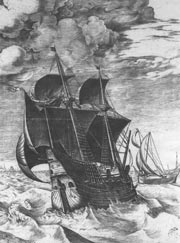| Discovering Asia's
ceramic development |
The value of shipwrecks
 Shipwrecks
which remain undisturbed on the seabed for centuries provide vital information
about the past. The challenge of archaeology is to understand the past by studying
material traces. On land, archaeologists may excavate burial sites, lost monuments
or deposited waste. At sea, marine archaeologists may excavate fully loaded
shipwrecks. Objects on board are usually assumed to be contemporary products
dating from the year of sinking. Objects recovered from such dated assemblages
yield important clues about Asia's development in ceramic know-how and maritime
trade.
Shipwrecks
which remain undisturbed on the seabed for centuries provide vital information
about the past. The challenge of archaeology is to understand the past by studying
material traces. On land, archaeologists may excavate burial sites, lost monuments
or deposited waste. At sea, marine archaeologists may excavate fully loaded
shipwrecks. Objects on board are usually assumed to be contemporary products
dating from the year of sinking. Objects recovered from such dated assemblages
yield important clues about Asia's development in ceramic know-how and maritime
trade.
Time capsules
Dating ceramics from production or burial sites often gives conflicting results.
Neither stratigraphy nor scientific dating is problem-free. Items included in
burials are particularly likely to be some years old by the date of internment.
Ceramic cargo found on shipwrecks is however likely to be contemporary. Scientific,
stylistic and historical analysis are all relevant for dating. Cross-referencing
the results of related shipwrecks can make the resultant puzzles more complex,
but ultimately allow dating with greater precision. Seven wrecks are exhibited
here.
'As time capsules, each with content deposited at a single moment in time,
these are more valid as dating evidence than are decades of scholarly guesswork
based on unprovenanced museum collections.'
Asian
Ceramic Research Organization
 Shipwrecks
which remain undisturbed on the seabed for centuries provide vital information
about the past. The challenge of archaeology is to understand the past by studying
material traces. On land, archaeologists may excavate burial sites, lost monuments
or deposited waste. At sea, marine archaeologists may excavate fully loaded
shipwrecks. Objects on board are usually assumed to be contemporary products
dating from the year of sinking. Objects recovered from such dated assemblages
yield important clues about Asia's development in ceramic know-how and maritime
trade.
Shipwrecks
which remain undisturbed on the seabed for centuries provide vital information
about the past. The challenge of archaeology is to understand the past by studying
material traces. On land, archaeologists may excavate burial sites, lost monuments
or deposited waste. At sea, marine archaeologists may excavate fully loaded
shipwrecks. Objects on board are usually assumed to be contemporary products
dating from the year of sinking. Objects recovered from such dated assemblages
yield important clues about Asia's development in ceramic know-how and maritime
trade.